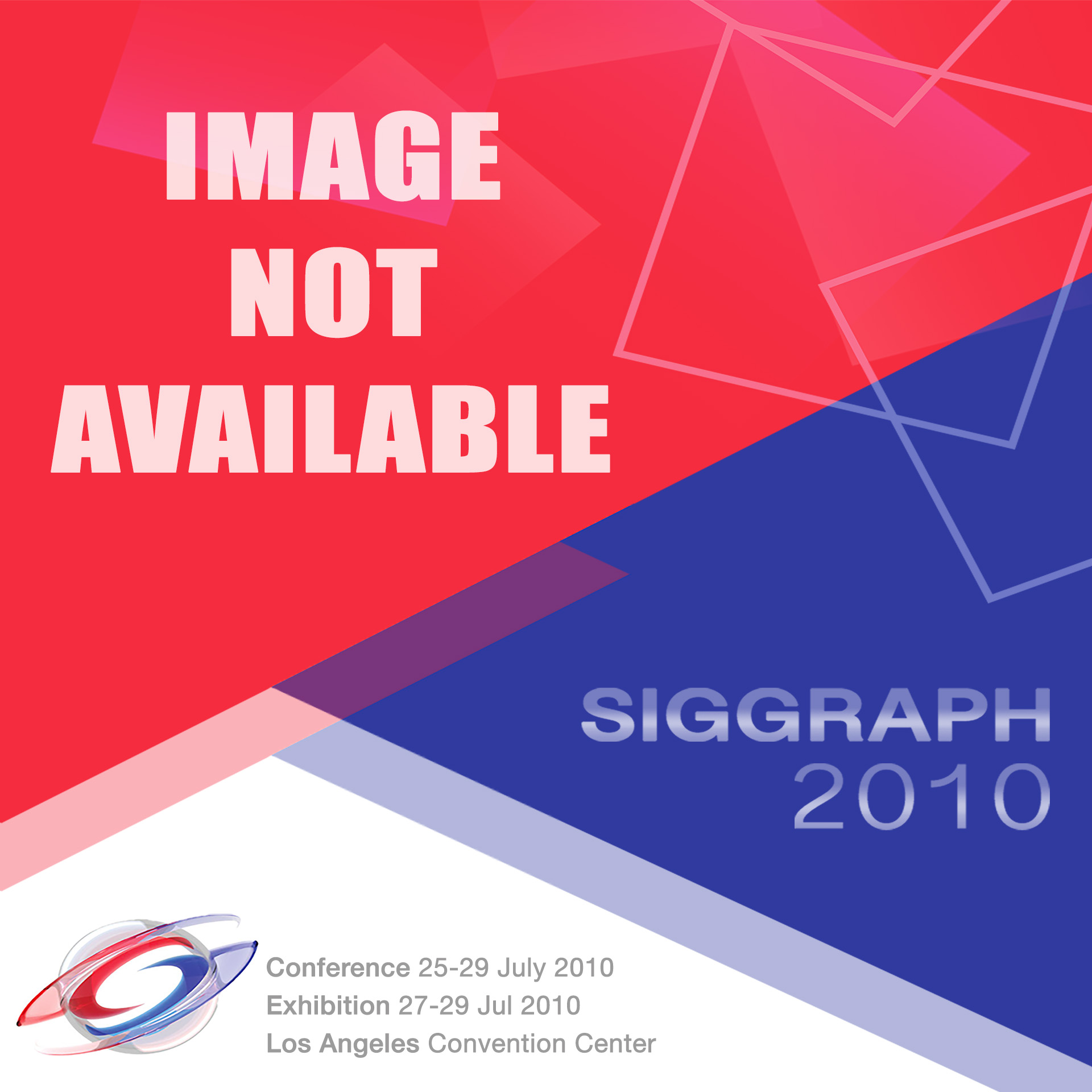“Underwater Cloth Simulation with Fractional Derivatives” by Ozgen, Kallmann, Ramirez and Coimbra
Conference:
Type(s):
Title:
- Underwater Cloth Simulation with Fractional Derivatives
Presenter(s)/Author(s):
Abstract:
We introduce the use of fractional differentiation for simulating cloth deformations underwater. The proposed approach is able to achieve realistic underwater deformations without simulating the Eulerian body of water in which the cloth is immersed. Instead, we propose a particle-based cloth model where half-derivative viscoelastic elements are included for describing both the internal and external dynamics of the cloth. These elements model the cloth responses to fluid stresses and are also able to emulate the memory-laden behavior of particles in a viscous fluid. As a result, we obtain fractional clothes, which are able to correctly depict the dynamics of the immersed cloth interacting with the fluid even though the fluid is not simulated. The proposed approach produces realistic underwater cloth deformations and has obvious advantages in simplicity and speed of computation in comparison to volumetric fluid simulation approaches.
References:
- Baraff, D. and Witkin, A. 1997. Physically based modeling: Principles and practice. In ACM SIGGRAPH’97 Course Notes.
- Baraff, D. and Witkin, A. 1998. Large steps in cloth simulation. In Proceedings of SIGGRAPH’98. ACM, 43–54.
- Basset, A. B. 1888. On the motion of a sphere in a viscous liquid. Trans. Royal Philos. Soc. London 179, 43–63.
- Boussinesq, J. 1885. Sur la résistance qu’oppose un liquide indéfini en repos, sans pesanteur, au mouvement varié d’une sphère solide qu’il mouille sur toute sa surface, quand les vitesses restent bien continues et assez faibles pour que leurs carrés et produits soient négligeables. C. R. Acad. Sci., 935–937.
- Breen, D., House, D., and Wozny, M. 1992. Predicting the drape of woven cloth using interacting particles. In Proceedings of SIGGRAPH’94. ACM, New York, 365–372.
- Carignan, M., Yang, Y., Magenenat-Thalmann, N., and Thalmann, D. 1992. Dressing animated synthetic actors with complex deformable clothes. In Proceedings of SIGGRAPH’92. ACM, New York, 99–104.
- Choi, K. and Ko, H. 2002. Stable but responsive cloth. In Proceedings of the SIGGRAPH’02. ACM, New York, 604–611.
- Coimbra, C. F. M. 2003. Mechanics with variable order operators. Annalen der Physik 12, 692–703.
- Coimbra, C. F. M. and Kobayashi M. H. 2002. On the viscous motion of a small particle in a rotating cylinder. J. Fluid Mech. 469, 257–286.
- Coimbra, C. F. M., L’Esperance, D., Lambert, A., Trolinger J. D., and Rangel R. H. 2004. An experimental study on the history effects in high-frequency Stokes flows. J. Fluid Mech. 504, 353–363.
- Coimbra, C. F. M. and Rangel, R. H. 1998. General solution of the particle equation of motion in unsteady Stokes flows. J. Fluid Mech. 370, 53–72.
- Desbrun, M., Schröder, P., and Barr, A. 1999. Interactive animation of structured deformable objects. In Proceedings of Graphics Interface. 1–8.
- Diethelm, K., Ford, N., Freed, A., and Luchko, Y. 2005. Algorithms for the fractional calculus: A selection of numerical methods. Comput. Meth. Appl. Mech. Engin. 194, 743–773.
- Eberhardt, B., Weber, A., and Strasser, W. 1996. A fast, flexible, particle-system model for cloth draping. IEEE Comput. Graph. Appl. 52–59.
- Hauth, M., Etzmuss, O., and Strasser, W. 2003. Analysis of numerical methods for the simulation of deformable models. The Visual Comput. 19, 7-8, 581–600.
- Hilfer, R. 2000. Applications of Fractional Calculus in Physics. World Scientific, River Edge, NJ.
- House, D. H. and Breen, D. E., Eds. 2000. Cloth Modeling and Animation. A. K. Peters, Ltd., Natick, MA.
- Hu, Y. 2005. Integral transformations and anticipative calculus for fractional brownian motions. In Memoirs of the American Mathematical Society.
- Kilbas, A., Srivastava, H., and Trujillo, J. 2006. Theory and Applications of Fractional Differential Equations. Elsevier, Amsterdam, The Netherlands.
- Larson, R. G. 1998. The Structure and Rheology of Complex Fluids. Oxford University Press.
- L’Esperance, D., Coimbra, C. F. M., Trolinger, J. D., and Rangel, R. H. 2005. Experimental verification of fractional history effects on the viscous dynamics of small spherical particles. Experim. Fluids 38, 112–116.
- Ling, L. 2000. Aerodynamic effects. In Cloth Modeling and Animation, D. H. House and D. E. Breen, Eds. A. K. Peters, Ltd., Natick, MA.
- Ling, L., Damodaran, M., and Gay, R. K. L. 1996. Aerodynamic force models for animating cloth motion in air flow. The Visual Comput. 12, 2, 84–104.
- Miller, K. and Ross, B. 1993. An Introduction to the Fractional Calculus and Fractional Differential Equations. John Wiley and Sons, New York.
- Müller, M., Schirm, S., Teschner, M., Heidelberger, B., and Gross, M. 2004. Interaction of fluids with deformable solids: Research articles. Comput. Anima. Virtual Worlds 15, 3-4, 159–171.
- Oldham, K. and Spanier, J. 1974. The Fractional Calculus. Academic Press, New York. San Diego, CA.
- Podlubny, I. 1999. Fractional Differential Equations. Academic Press, San Diego, CA.
- Provot, X. 1995. Deformation constraints in a mass-spring model to describe rigid cloth behavior. In Proceedings of Graphics Interface. 147–155.
- Robinson-Mosher, A., Shinar, T., Gretarsson, J., Su, J., and Fedkiw, R. 2008. Two-Way coupling of fluids to rigid and deformable solids and shells. ACM Trans. Graph. 27, 3, 1–9.
- Selle, A., Su, J., Irving, G., and Fedkiw, R. 2009. Robust high-resolution cloth using parallelism, history-based collisions, and accurate friction. Trans. Visual. Comput. Graph. 15, 2.
- Stokes, G. G. 1845. On the theories of internal friction of fluids in motion. Trans. Cambridge Philos. Soc. 8, 287–305.
- Terzopoulos, D. and Fleischer, K. 1988. Deformable models. The Visual Comput. 4, 6, 306–331.
- Terzopoulos, D., Platt, J., Barr, A., and Fleischer, K. 1987. Elastically deformable models. In Proceedings of SIGGRAPH’87. ACM, New York, 205–214.
- Tu, X. and Terzopoulos, D. 1994. Artificial fishes: Physics, locomotion, perception, behavior. In Proceedings of SIGGRAPH’94. ACM Press, New York, 43–50.
- Volino, P., Courchesne, M., and Thalmann, N. M. 1995. Versatile and efficient techniques for simulating cloth and other deformable objects. In Proceedings of SIGGRAPH’95. ACM, New York, 137–144.




